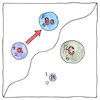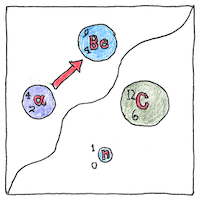Irène
Joliot-Curie, Frédéric
Joliot-Curie
physics

|
Induced radioactivity
After bombarding atoms with protons to measure the recoil of nuclei, Irène and Frédéric Joliot-Curie discovered that they had made non-radioactive elements radioactive. They transmuted stable elements into heavier radioactive elements, creating radioactive nitrogen from boron, unstable isotopes of phosphorus from aluminum, and radioactive silicon from magnesium.
Uses
Their work led to the production of radioactive isotopes for medicine, the discovery of the positron and the neutron. and the discovery of nuclear fission. In 1939, the Joliot-Curies locked up their documents on nuclear fission to prevent it being used to make bombs.
Everybody’s doing it
Ernest Rutherford bombarded nitrogen with protons to make oxygen. Irène and Frédéric Joliot-Curie bombarded boron to make nitrogen; they bombarded aluminum, bombarded magnesium. They made heavier elements out of lighter ones. Enrico Fermi bombarded uranium with neutrons, trying to make heavier elements. Otto Hahn and Fritz Strassmann bombarded uranium but they found they had made boron, a lighter element. Lise Meitner said they split the nucleus; Otto Frisch called it fission. Frédéric Joliot-Curie said it was a chain reaction. Once the Germans did it then the Americans had to do it.



Memes, like diseases, have been shown to be infectious, but few have been as powerful as a nation’s notion of superiority.
See also in The book of science:
Readings in wikipedia: